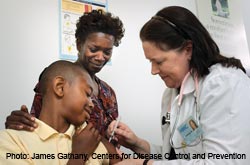
Children from six months of age and young people up to 24 years of age are particularly at risk this year from the 2009 H1N1 flu. They are among the groups being given priority to receive the H1N1 vaccine (either shot or mist).
Each year, from late fall through early spring, there are outbreaks of seasonal flu. In addition to this year's seasonal flu, there is the 2009 H1N1 flu virus. This is causing a more dangerous flu season. More people than usual are getting sick, being hospitalized, and dying than during a typical flu season. Vaccines for seasonal flu and 2009 H1N1 flu are available to help people prevent coming down with them. Here's what you need to know to help avoid getting and passing on the flu.
Influenza (Seasonal)
The flu is a contagious respiratory illness caused by influenza viruses. It causes mild to severe illness and can sometimes lead to death. The best way to prevent seasonal flu is by getting a flu shot each year. In the U.S. each year on average,
- 5 to 20 percent of the population gets the flu,
- more than 200,000 people are hospitalized from flu-related complications, and
- about 36,000 people die from flu-related causes.
Older people, young children, and people with asthma, diabetes, heart disease, and other conditions are at high risk for serious flu complications.
2009 H1N1 Influenza
The 2009 H1N1 flu is caused by a different virus than the seasonal flu. Its symptoms are similar to those of seasonal flu, including fever, cough, sore throat, body aches, headache, chills, and fatigue. But those most at risk for 2009 H1N1 are different from those most vulnerable to the seasonal flu. Although sometimes incorrectly called "swine" flu, 2009 H1N1 is not the 1976 swine flu virus. People vaccinated against swine flu in 1976 should still get the 2009 H1N1 vaccine.
H1N1 Flu: Who Should Be Vaccinated First
The Centers for Disease Control and Prevention (CDC) is urging everyone to get both the seasonal and H1N1 vaccines. The 2009 H1N1 vaccine, either by injection or nasal spray, does not replace the seasonal flu shot. It is intended to be used with it.
People most at risk from 2009 H1N1 flu and being given priority to receive the first doses of H1N1 flu vaccine include:
- Pregnant women;
- People caring for infants six months or younger, because younger infants are at higher risk of influenza-related complications and cannot be vaccinated;
- Healthcare and emergency medical services personnel, who can be a potential source of infection for
vulnerable patients; - Everyone from 6 months through 24 years of age; and
- People aged 25 through 64 years with asthma, diabetes, heart disease, and other health conditions associated with high risk from flu complications.
—Centers for Disease Control and Prevention (CDC)
